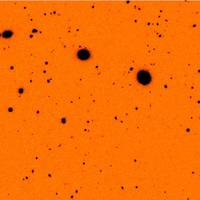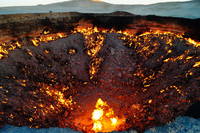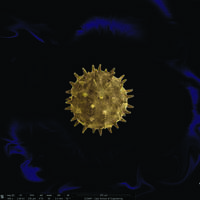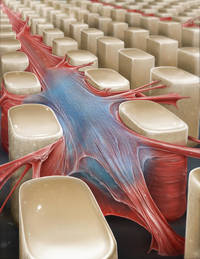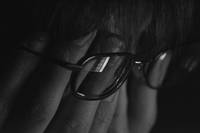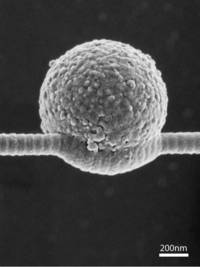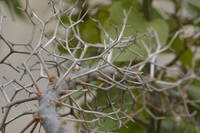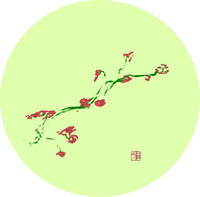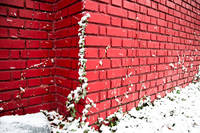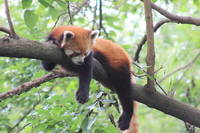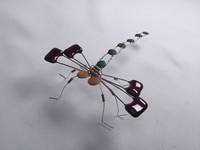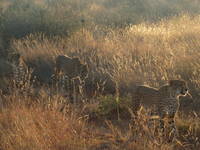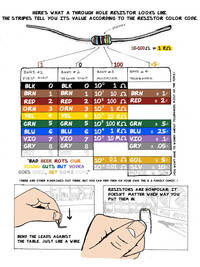- Art of STEM - CWRU Entries (x)
- Search results
Search results
Show moreThis photograph is beautiful. Although it may only appear to be a few dark blobs in a sea of orange, it represents the greatest phenomenon in the Cosmos: the constant speed of light. The tiniest, faintest, black points in the center of the image are photons that left a cluster of galaxies 2 billion years after the Big Bang, and have ceaselessly battled the expansion of the Universe to land on the lens of a telescope on Earth. As the Universe expanded, it shifted what used to be green light (from the most ancient, long dead stars) into the infrared, more than three times redder than our human eyes can detect. This photograph is beautiful because a graduate student in Cleveland can peer beyond the mists of time to examine the ghosts of galaxies assembled at the dawn of the Universe. (12"x12" negative image from WIRCam at a wavelength of 2.25 microns, courtesy of the Canada-France-Hawaii Telescope Archive, analyzed by J.R. Franck).
Show less
Show more"Given a flaming crater that reaches temperatures well in excess of 750 degrees Fahrenheit, it's not hard to see why locals refer to this otherworldly place as the ""Door to Hell."" While officially named the Darvaza Crater, this formation is a reminder of humanities precarious relationship with nature. In 1971, Soviet scientists were exploring the natural gas reserves of the Karakum Desert, Turkmenistan when their drilling rig unexpectedly collapsed into an underground cavern. 44 years later, the flames are still raging. A testament to the importance of being cautious when working with our environment. This Photograph was taken by Neal Mathes on July 30, 2014 during a family trip through Central Asia."
Show less
Show morePlants release pollen into the air as part of their reproductive process. Humans breathe in the pollen and the body mistakes it for invading germs, triggering the body's defense, resulting in a sneeze to expel the intruder out. Image was taken using a Helios NanoLab 650 electron microscope at the Swagelok Center for Surface Analysis of Materials. It measures approximately 100 microns in diameter. The single grain of pollen was cut from the full microscope image, colorized using Photoshop and imposed on to a stylized background.
Show less
Show moreThe image illustrates a microfabricated three dimensional (3D) substrate to confine, align, and elongate biological cells. Pillar top surfaces are rendered non-adhesive to cells and sidewalls of the micropillars were functionalized to allow adhesion of cells in the inter-pillar space. Biological cells, such as stem cells and heart muscle cells, can be confined in a 3D micropillar environment with precise control over mechanical properties, so cell behavior in response to various mechanical effects can be characterized. I would like to acknowledge my team member Grace Gongaware from Cleveland Institute of Art and my supervisor Dr. Umut Gurkan for contemplating and crafting this image.
Show less
Show moreThe content of this image consists of a friend working on code in C++ in a dark room at night. The only light in the room is from the computer screen, and the shot is taken as he pauses to rub his eyes. The image was taken with a Nikon D7100 and a 300m lense. The photo was slightly edited in Photoshop to creating a lighting effect that centered on the code reflected in his glasses. This should be printed on a 24(W)X16(H) to fit the pixel count well.
Show less
Show moreThis is a postcard for a lecture and film screening I organized on campus last fall. The lecture was by NASA engineer Matt Melis, who spoke on the Columbia accident investigation; the film, screened by the CWRU Film Society, was "Ascent: Commemorating Shuttle," which he produced. (It can be found on YouTube; highly recommended for space and/or photography enthusiasts.) My initial idea for the postcard was in art nouveau style, with an ornate frame featuring text about the event and mission badges. Ultimately I wound up scrapping that, because I had trouble capturing the way it had looked in my head, and because the text began to seem like too much of a distraction. I kept the flat colors and heavy outlines, which made it look more like a stained glass window. This struck me as appropriate, because launch vehicles always exist on a mythical scale. As the shuttle program fades into history, it joins that pantheon, loses its immediacy, and becomes more abstracted in our collective understanding, like a historical figure turned religious icon. I also wanted to show the shuttle frozen in time in a kind of repose, nestled into the clouds - a real contrast with the violence of a launch, but the kind of visual that suggests itself when you watch from a distance - which the edgeless panel is well-suited for. I want the viewer across the room to look at it on a bulletin board (long after the event it advertised is over) and feel themselves press "pause." I hope it worked on you. ------------------------------------------------ Size: 4"x9"
Show less
Show moreAn interesting plant whose branches followed a completely orderly pattern while rotating around the limb. This was taken at Mission San Jose in San Antonio, Texas. The camera used was a Nikon D7100 with a 300m lense. Print on 24(W)X16(H).
Show less
Show moreHuman motor function is dependent on neuromuscular junction that links nerve system and muscular tissues. The integrity of neuromuscular junction is impaired in many human diseases including amyotrophic lateral sclerosis (ALS), which is well known as the ALS Ice Bucket Challenge. The pathogenesis of ALS is not well understood and there is no cure for this fatal disease. Presented above is a confocal image revealing the structure of neuromuscular junction of transversus abdominis muscle isolated from ALS transgenic mouse. Tissue section was stained using mouse anti-neurofilaments antibody (green) to show nerve fibers in muscle. Nicotinic acetylcholine receptors, which are presynaptic marker to transmit nervous signal to muscular tissues, were stained by dye conjugated bungarotoxin (red). The specimen was imaged with a 40x air objective using spinning disk confocal. Author's seal is presented in Chinese in lower right.
Show less
Show moreThis photo was taken on a snowing day the past winter. The color of this Boston-ivy drew my attention when I was walking back to the North Residential Village. Some branches of it were already dead and turned to yellow. The only branch that is still alive was covered with snow, but it still shows its energy to keep growing higher and conquering the bad weather. Boston-ivy seems to die every winter, but it will always come back to live the next spring. Cleveland is cold, but the spirit of Boston-ivy warms our world up.
Show less
Show moreThis is a digitally drawn cut-away view of a human head with a brain composed of a schematic of several circuits including many resistors, transistors, capacitors, and diodes. This was inspired from the fact that our brains work based on electrochemistry, and electricity flows through the brain just as electricity flows through a circuit. The programs used were Adobe Photoshop, Krita, and Microsoft Paint.
Show less
Show moreThis graphic piece is inspired by imagery of fighter jets piercing the sound barrier and the science behind that process. As pressure builds progressively at the front of the jet, a cone is formed, which is effectively "pierced" when the jet breaks the sound barrier. This successive process, depicted in my piece, relates to the form of my favorite jet, the F-16.
Show less
Show more"Noon on a Sunday afternoon, an Ailurus fulgens (Red Panda) wakes from a day nap astride Morus nigra (Blackberry) tree some 15 meters high. Rest is both relaxing, hunting, and camouflage. The subtle fur changes color along the ventral with the dorsal planes exhibiting a delightful contrast. The top fur resembles the red and dark brown soil; the lower coat blends with the darker tones of bark and shaded earth. With keen senses of smell, hearing, and eyesight Ailurus fulgens can identify components of its omnivorous diet atop the branches. Ultimately however, the red panda's draped limbs counter balance with its tail allowing carefree napping. 6/15/2014, Chengdu Research Base of Giant Panda Breeding, Chengdu, Sichuan, People's Republic of China"
Show less
Show more"Shown is an evolving view of a hypothetical phase transition in the hot, early universe in which bubbles form, grow and eventually collide and coalesce. From left to right, the progress of the phase transition is shown. Bubbles of a new phase are created (yellow), which proceed to expand at relativistic speeds, creating density waves in the ambient matter (blue) as they grow. After the bubbles collide, a turbulent thermalization process takes place. Simulations of this transition were run using computing resources at Case Western Reserve University, Kenyon College, and the Ohio Supercomputer Center. Data from simulations was processed using Mathematica and rendered using 3ds Max."
Show less
Show moreIncorporation of STEM: By merely using technology, a form of science, I utilized science as a device to create this piece. Primarily computer science was used to create it. I used the program Adobe Photoshop to create this composition. To create the composition, I took myriad photographs and scans to be utilized as frames of the piece, a clear use of technology in the work. The use of technology is also emphasized in the claw that is on the far left side of the composition. I used LEGO pieces to construct the apparatus and extended it to achieve the desired shapes. In turn, a considerable amount of engineering was utilized to make and extend the claw. Mathematics was used to create the transparent architectural sketch on the right side of the composition. Extra Information: This personal map is a culmination of my thoughts of my past and how the future (forcefully) brings them together. The left side of the piece is clearly dimmer, implicating the past. The faded flower at the extreme left is the harbinger of the start of my tolerance for my mixed heritages. The upper tier of the typhoon depicts the first family reunion of my father's lineage: the African American Davis' are shrouded in savanna-like thickets, representing my lack of familiarity with my fraternal heritage. The lower tier of the typhoon depicts a more recent family reunion: me amongst my less alienating Japanese cousins and grandmother. My attachment to this lineage is represented by a fragment of my Japanese language notes. The two tiers are divided by my radiated arm emerging from claws which propel it to the present and future. Additional appendages sprout in protest, depicting my inner struggle to tolerate a change of my cultural idiosyncrasy. Into my unknown future, a light of change is not grasped by the arm, but it instead absorbs the arm and the typhoon into one unstable yet defined focus. Amid the turbulence, the two landscapes of the left switch places and witness the blend. They fade into the background, omnipresent yet unobtrusive in the light of my future career of architecture. One of my conceptual sketches blends in with the harmonious families, implying that my newfound tolerance will undoubtedly benefit my success in later years.
Show less
Show moreThe variations in crystal structure within this melting ice diffract light in different ways, such that an opaque cloud appears to be trapped inside this melting ice cube. This "cloud," a formation normally suspended in the air, is here suspended instead in a solid block of ice.
Show less
Show moreDepicted are individual collagen fibers extracted from the tissue of the tail of the rats in solution. Collagen is a protein found in the connective tissue between cells and is one of the most abundant proteins in the human body, with estimates of 25 to 35 percent of all protein content. This picture was taken by means of dark field microscopy, a special technique that must be used due to the fact the collagen fibers would be impossible to see in solution using ordinary bright field microscopy. This image was taken with help from Yehe Liu and was part of an effort to better understand the micro level mechanical characteristics of an individual collagen fibril.
Show less
Show moreOnce a week, I teach an electronics class for high school girls at Beaumont School in Cleveland Heights. I couldn't find a basic electronics textbook I really liked, so I started drawing a comic book for them. This is one of the pages from that comic, which serves as a reference for the resistor color code. I find that the needs of technical communication "expressing a concept in multiple ways, showing how ideas relate to and build on each other, getting your point across whether the reader skims or ruminates" are perfectly suited to the words-and-pictures alchemy of comics. This page uses a combination of techniques I've learned from both engineering drafting and comic illustration, echoing engineering drawings in ligne claire style and making use, naturally, of color coding. And when I pass it out to my students, it's stapled like an old school `zine. Size: 9" by 12" Method: Pencil and ink on Bristol board, colored and lettered in Photoshop. This entry won second place in the CWRU category.
Show less

